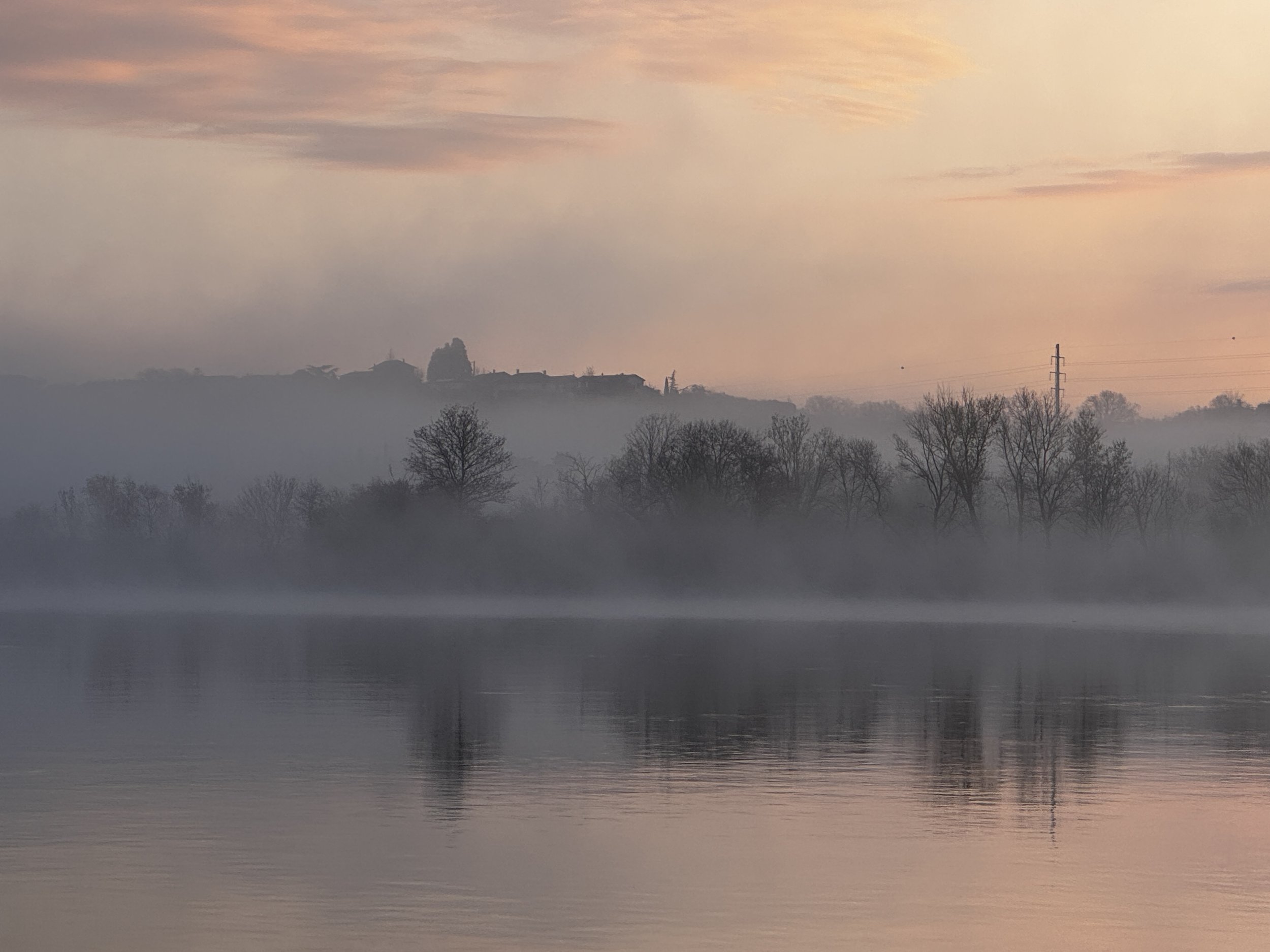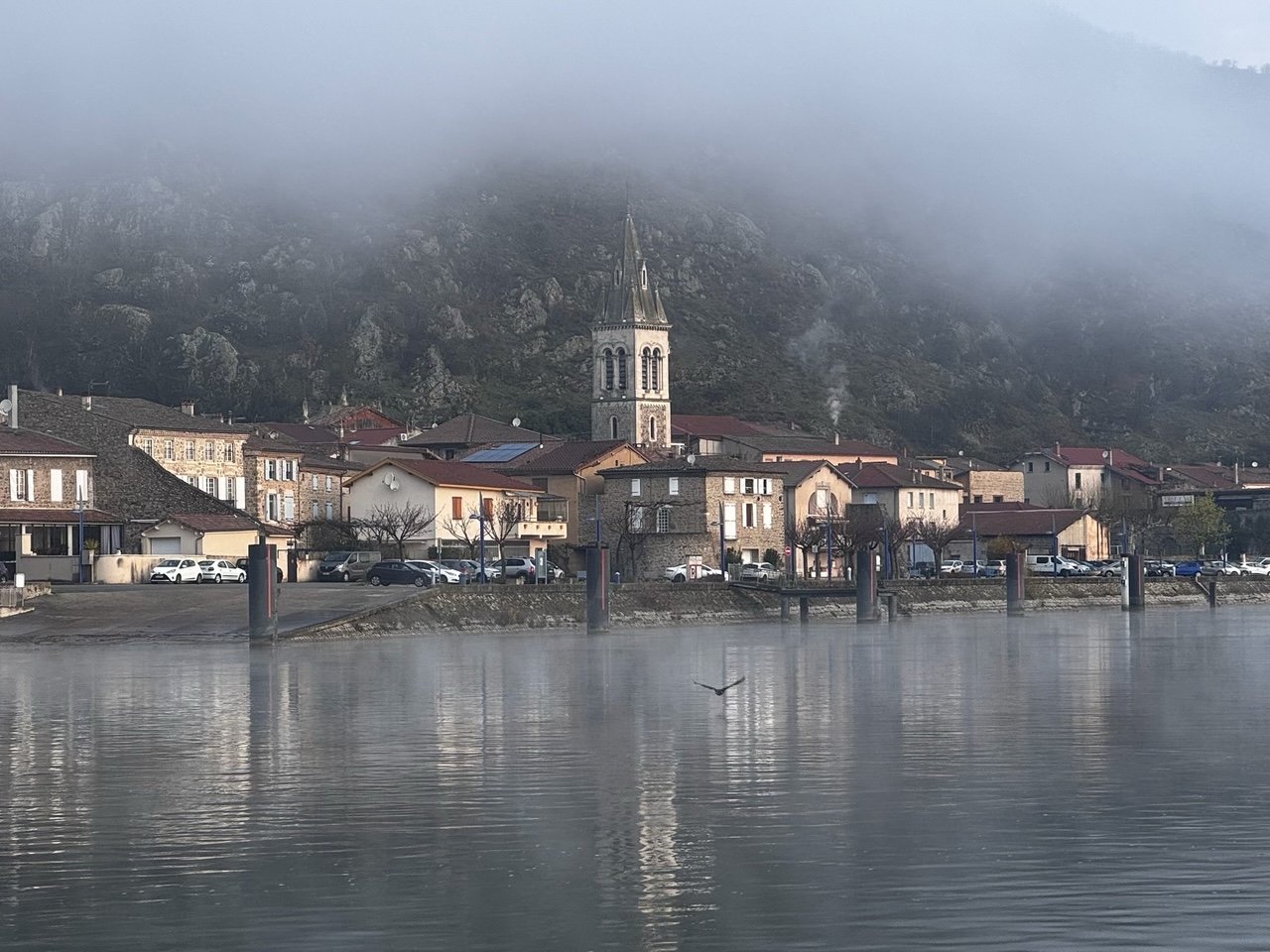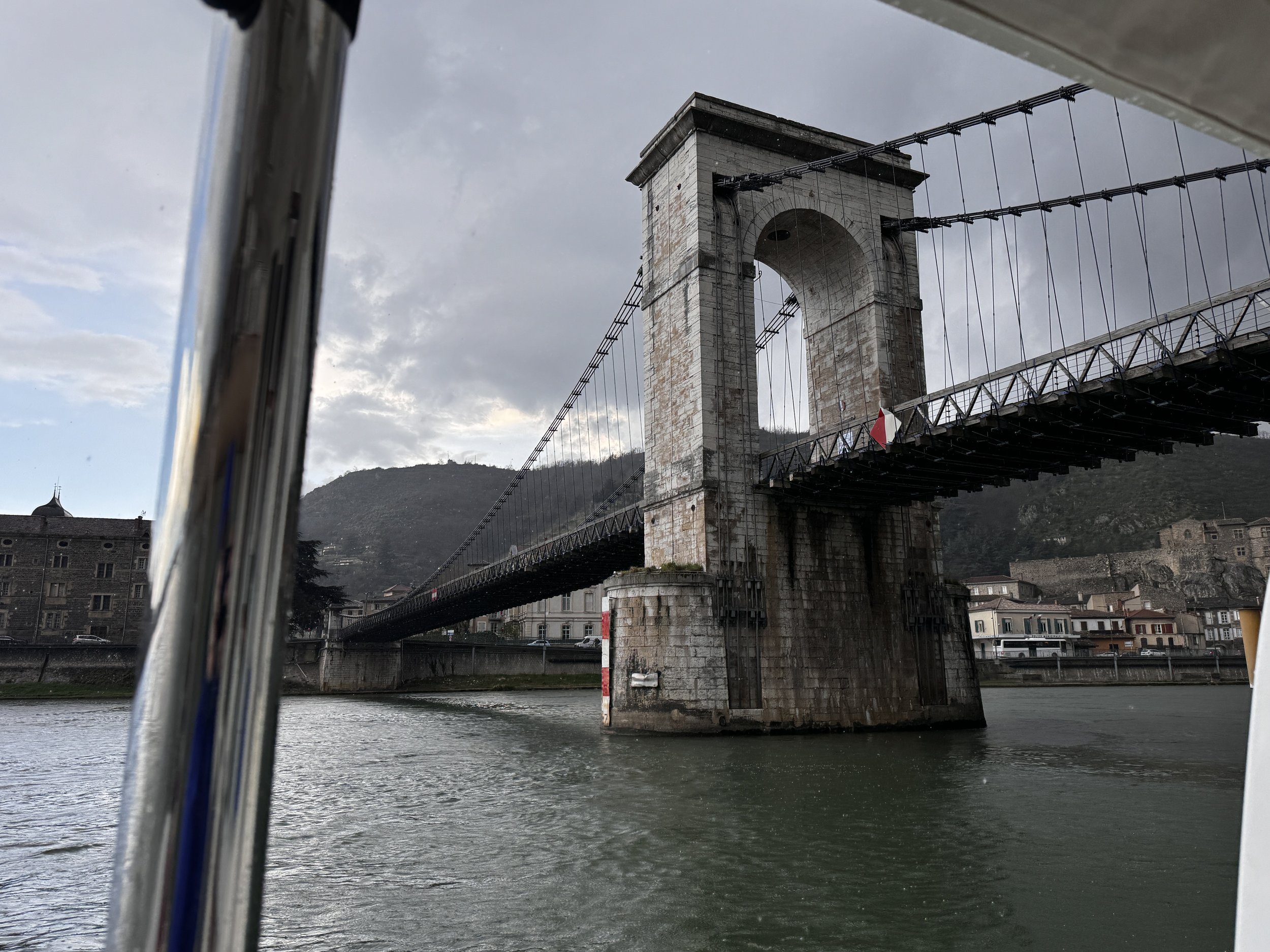Constant Novelty
I awoke in the wee hours to a dream of sheared dock lines and frantically attempting to manage our floundering boat inside a lock. When I eventually drifted back to sleep the same dream picked up where it had left off. I arose super early and drank a cup of tea in the dark. Tom awoke a couple of hours later, made coffee and at the crack of dawn we slipped the lines in the marina quietly drifting into the flow of the river. I hoped my dream would not be a portent of what was to come.
The marina manager had told us that the VNF, the French navigation authority responsible for management of the inland waterways network, concentrated their attention strictly on commercial traffic and had little interest in supporting the businesses and communities catering to the private boater. This explained why there are so few pontoons available for pleasure craft along the lower Rhône, and meant that we would again have quite a few river miles to cover before stopping for the night.
We arrived at our first lock, Bourg-lès-Valence, by 7:15am. A large barge had just motored past us exiting downstream so we figured the lock would be at the bottom - ready for upstream travel. As usual, I radioed the lock-keeper announcing our arrival. They responded that they were preparing the lock. We waited in the flow outside the entrance for a few minutes and I was just beginning to wonder why it was taking so long when we were hailed on the radio and told the lock was not working properly. We motored over to the waiting pontoon and tied up figuring it would just take a few minutes. An hour went by. I became super restless. I thought about taking a walk but I wasn’t sure how long we would be standing by - we needed to be ready when the lock reopened. Another hour passed. Impatient, I decided to make breakfast - surely once I started cooking the lock would open! But, I was wrong. While we ate breakfast an enormous barge, the Occitania, arrived and tied up to the dolphin pilings behind us. My thoughts wandered; how far would we be able to travel with this delay? Would we be spending the entire day at this pontoon? Where would be when it got dark? Would there be anywhere to stop for the night? Needing to clear my racing thoughts, I meditated and eventually settled down to write a blog post. Time ticked by slowly. A second barge arrived and tied up at the dolphins behind the first. Morning turned into afternoon. I made lunch and washed the dishes. We drank a cup of tea. At long last, around 2:40pm, I noticed a green light on the lock, jumped to my feet and ran outside. The Occitania was just now cruising past us and the smiling captain appeared from the bridge enthusiastically waving me along into the lock behind him. I quickly radioed the lock-keeper to inquire if this were possible. They asked our boat length and we were given permission to accompany the barge! Hooray - we were off again! We leapt to work untying our dock lines - preparing them for locking-up, donned our life jackets and followed them inside.
That is one MASSIVE barge!
We emerged from the upstream side around 3:20pm and immediately began calculating our expected progress having lost nearly 8 hours of travel time. There were a couple of halts depending on how much further we felt like going as evening approached. Had my dream been a premonition of this obstruction? Who knows, but I was certainly thankful to be navigating this beautiful valley once again.
We passed terraced hillsides and under one of only three bridges that survived the floods and spring ice flows on the Rhône in the beginning of the 19th century. Designed by Marc Seguin, a French civil and mechanical engineer born in 1768, it was originally erected in 1825 between Tournon and Tain l'Hermitage and had two spans of 290 feet each. It was converted to a pedestrian bridge in 1847 because it was blocking river traffic, so Seguin built another bridge a few hundred yards away which opened in 1849. The original 1825 bridge was torn down but the1849 bridge still stands today.









We climbed one more lock before arriving at our pontoon for the night in Saint-Vallier. The river here was broad and the current hardly noticeable. We were gently idling forward towards the dock, I was ready at the bow to toss the line, when I felt a bump beneath me. Our keel had just touched the ground. “We just hit the bottom,” I said to Tom, who calmly replied “yep, we’re aground.” But we weren’t actually stuck, the boat was still moving and Tom smoothly maneuvered us further from the shore. We proceeded further upstream in line with the dock and then sidled into it rather than a gradual diagonal approach. It was bound to happen, we had expected to drag the keel through the mud at some point, it’s just a bit disconcerting when it does occur.


Mornings on the river are magical. I wander out on deck at dawn, the songbirds are just waking up and chattering to one another, the river appears composed and pleased with herself while a pink ephemeral mist blooms on the surface and then gently disappears into the golden light of day.







But on this particular morning the river was socked in with dense fog and seemed bewildered and irritable. The clouds thickened even more as we rounded a bend in the river obscuring the banks on both sides. I donned a headset and went forward as lookout as Tom slowed us down. I’ve never liked boating in the fog - getting caught in it in Alaskan waters is my worst nightmare. Here, river boats, especially those without AIS (Automatic Identification System), and of course the large barges that take wide sweeping turns through the curves, were our biggest concern.
I also scanned for debris in the water. The fog billowed up off the surface in places offering us brief windows into what lay ahead. There was a barge shown on AIS heading downstream towards us traveling three times our speed. I focused on the glimpses of light illuminating the water in patches and willed us to be in a clear spot when our boats passed. Thankfully that’s exactly what happened. Visibility improved briefly when the barge passed on a relatively straight stretch of the river, before the gloom descended again. It was a moody morning on the river but the sun was getting higher in the sky and I knew the fog would eventually burn off with the warming air.
Indeed, a mellow day followed, passing through countryside blanketed by a geometric patchwork in hues of greens and gold. There were vineyards everywhere! The Rhône Valley is one of the most prominent wine regions on earth, with more than 6,000 wine-growing properties producing, distributing and exporting wine to the rest of the world on a massive scale.






















We had but one final lock on the Rhône before reaching the big city of Lyon. As we approached we were overtaken by a fast moving hotel barge. The guests all waved as they zipped past and entered the lock. As usual I had called ahead and we were told to proceed. When we arrived at the entrance however another small pleasure boat was motoring inside. We watched them tie up on the right side of the chamber which meant we would need to lock up on the left. Up until this point we’d never been overtaken by a barge, we’d not seen any other pleasure boats our size or smaller, we’d never locked up with three vessels and never on the left side of the lock. I hurriedly prepared the lock lines and fenders on our port side. We had just gotten ourselves secured, albeit not super gracefully, when we were hailed on the radio by the eclusier (lock-keeper). Apparently they were unable to communicate with the other pleasure craft and needed me to relay their information. I shouted to the man across from us in the echoing chamber and related it back to the eclusier. What was the name of their boat? Where was it flagged? More questions followed, some of which the man didn’t seem to understand or remember - for example, where had they departed from this morning? He kept muttering the name of a town but then would trail off and sheepishly shrug. It was an older German couple aboard and perhaps the names of the French towns they’d stopped in were difficult to pronounce or maybe forgotten. Frustrated with my failing role as liaison I decided to make something up - I picked a random town that we’d passed and told the eclusier which seemed to satisfy. Finally we could continue. As the water rose I chatted with the Germans and learned where they’d been and that they were headed home to Germany over the next three months. I also discovered they were on the wrong radio channel which was why they couldn’t communicate directly with the lock-keeper. Hopefully they will not have to deal with this on the remainder of their trip.







As we approached the big city a couple of hours later we recognized the Occitania, from our long delay yesterday, heading back downstream. Clearly they had completed their journey up river, unloaded, reloaded, and were already heading back with more cargo. This barge brought a smile and once again the friendly captain stepped out onto the bridge and waved in acknowledgment as we passed. It felt like such a warm welcome to Lyon.
Arriving in the big city felt like an accomplishment. The Rhône River originates in Switzerland from the Rhône Glacier in the Swiss Alps and meanders to the southwest from Switzerland into France, meeting the Saône River in the vicinity of Lyon. It then flows south through southeastern France to the Mediterranean Sea. Near its mouth, at the city of Arles in Provence, the Rhône splits into two branches, the Great Rhône and the Petit Rhône, forming a delta in the Camargue region. In total it is approximately 812 km (504 miles) long — we had now voyaged the lower Rhône, a 325 km (202 mile) section, and all twelve locks between the mouth of the Saône River and the Mediterranean Sea.
We tied ourselves to a quiet stretch of the town quay and set off in search of a glass of wine, content in the knowledge that the temperamental Rhône had not defeated us and new adventures were around the next bend on a whole new river.












Note: photo captions will not appear if viewing on a cell phone.






